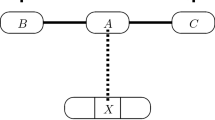Abstract
Graphs considered in this paper are finite, undirected and without loops, but with multiple edges. For an integer \(t\ge 1\), denote by \(\mathcal{MG}_t\) the class of graphs whose maximum multiplicity is at most t. A graph G is called strictly t-degenerate if every non-empty subgraph H of G contains a vertex v whose degree in H is at most \(t-1\). The point partition number \(\chi _t(G)\) of G is the smallest number of colors needed to color the vertices of G so that each vertex receives a color and vertices with the same color induce a strictly t-degenerate subgraph of G. So \(\chi _1\) is the chromatic number, and \(\chi _2\) is known as the point aboricity. The point partition number \(\chi _t\) with \(t\ge 1\) was introduced by Lick and White (Can J Math 22:1082–1096, 1970). If H is a simple graph, then tH denotes the graph obtained from H by replacing each edge of H by t parallel edges. Then \(\omega _t(G)\) is the largest integer n such that G contains a \(tK_n\) as a subgraph. Let G be a graph belonging to \(\mathcal{MG}_t\). Then \(\omega _t(G)\le \chi _t(G)\) and we say that G is \(\chi _t\)-perfect if every induced subgraph H of G satisfies \(\omega _t(H)=\chi _t(H)\). Based on the Strong Perfect Graph Theorem due to Chudnowsky, Robertson, Seymour and Thomas (Ann Math 164:51–229, 2006), we give a characterization of \(\chi _t\)-perfect graphs of \(\mathcal{MG}_t\) by a set of forbidden induced subgraphs (see Theorems 2 and 3). We also discuss some complexity problems for the class of \(\chi _t\)-critical graphs.

Similar content being viewed by others
References
Andres, S.D.: On characterizing game-perfect graphs by forbidden induced subgraphs. Contrib. Discrete Math. 7, 21–34 (2012)
Andres, S.D., Hochstättler, W.: Perfect digraphs. J. Graph Theory 79, 21–29 (2015)
Bang-Jensen, J., Bellitto, T., Schweser, T., Stiebitz, M.: Hajós and Ore construction for digraphs. Electron. J. Combin. 27, P1.63 (2020)
Bang-Jensen, J., Havet, F., Trotignon, N.: Finding an induced subdivision of a digraph. Theor. Comput. Sci. 443, 10–24 (2012)
Berge, C.: Some classes of perfect graphs. In: Six Papers on Graph Theory, Indian Statistical Institute, pp. 1–21. Mc Millan, Calcutta (1963)
Bollobás, B., Manvel, B.: Optimal vertex partition. Bull. Lond. Math. Soc. 11, 113–116 (1979)
Chudnovsky, M., Cornuéjols, G., Liu, X., Seymour, P., Vušković, K.: Recognizing Berge graphs. Combinatorica 25, 143–186 (2005)
Chudnovsky, M., Robertson, N., Seymour, P., Thomas, R.: The strong perfect graph theorem. Ann. Math. 164, 51–229 (2006)
Gasparian, G.S.: Minimal imperfect graphs: a simple approach. Combinatorica 16, 209–212 (1996)
Grötschel, M., Lovász, L., Schrijver, L.: The ellipsoid method and its consequence in combinatorial optimization. Combinatorica 1, 169–197 (1981)
Grötschel, M., Lovász, L., Schrijver, L.: Geometric Algorithms and Combinatorial Optimization (Second corrected edition). Springer, Berlin (1993)
Hajós, G.: Über eine Konstruktion nicht \(n\)-färbbarer Graphen. Wiss. Z. Martin Luther Univ. Halle-Wittenberg Math.-Natur. Reihe 10, 116–117 (1961)
Hedetniemi, S.T.: On partitioning planar graphs. Can. Math. Bull. 11, 203–211 (1968)
Lick, D.R., White, A.: \(k\)-degenerate graphs. Can. J. Math. 22, 1082–1096 (1970)
Lovász, L.: A characterization of perfect graphs. J. Combin. Theory Ser. B 13, 95–98 (1972)
Lovász, L.: Normal hypergraphs and the perfect graph conjecture. Discrete Math. 2, 253–267 (1972)
von Postel, J., Schweser, T., Stiebitz, M.: Point partition number: decomposable and indecomposable critical graphs (2019). arXiv:1912.12654. Accessed 17 July 2021
Author information
Authors and Affiliations
Corresponding author
Additional information
Publisher's Note
Springer Nature remains neutral with regard to jurisdictional claims in published maps and institutional affiliations.
Rights and permissions
About this article
Cite this article
von Postel, J., Schweser, T. & Stiebitz, M. Point Partition Numbers: Perfect Graphs. Graphs and Combinatorics 38, 31 (2022). https://doi.org/10.1007/s00373-021-02410-w
Received:
Revised:
Accepted:
Published:
DOI: https://doi.org/10.1007/s00373-021-02410-w




